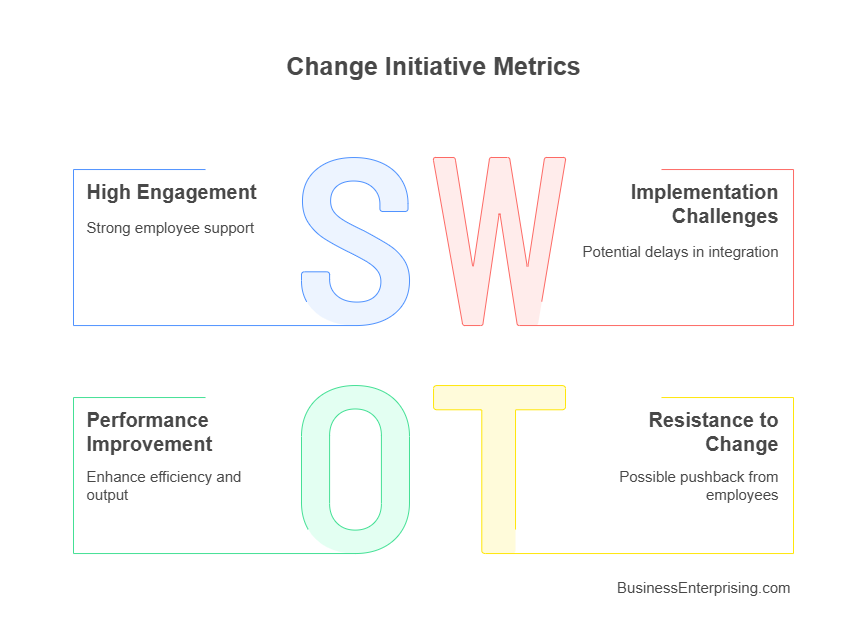
Involving stakeholders in defining success criteria enhances buy-in and relevance. Engaging employees, managers, and other key parties ensures that diverse perspectives shape the evaluation metrics. This collaborative approach fosters a shared understanding of what success looks like, increasing commitment to the change process. Furthermore, regular communication about these criteria keeps everyone informed and aligned. Therefore, stakeholder involvement is essential for setting realistic and accepted success measures.
Regularly reviewing and adjusting success criteria is vital in a dynamic business environment. As projects evolve, initial goals may need refinement to reflect new insights or changing circumstances. This flexibility allows organizations to remain responsive and maintain the relevance of their evaluation metrics. Additionally, continuous monitoring enables proactive identification of issues, facilitating timely interventions. Therefore, an adaptive approach to success criteria supports sustained effectiveness in change initiatives.
Defining success in change management requires setting clear, aligned, and adaptable criteria. Engaging stakeholders and maintaining flexibility in these metrics are key to accurately evaluating the effectiveness of change initiatives. This structured approach ensures that organizations can navigate change effectively, leading to improved performance and goal attainment.
Defining Success in Change Management
Defining success in change management is essential for achieving organizational goals. Establishing clear criteria allows you to assess whether a change initiative meets its objectives. This clarity guides your team and aligns efforts toward desired outcomes. Measuring success in change management involves setting specific, measurable, achievable, relevant, and time-bound (SMART) goals. These goals provide a concrete framework to evaluate progress. For example, if you’re implementing a new software system, a SMART goal might be achieving 90% employee adoption within six months. This target offers a clear benchmark for success.
Additionally, understanding the reasons behind the change is crucial. Aligning the technical and people sides of change ensures comprehensive success. By defining what you aim to achieve and communicating it effectively, you set the stage for successful change management. Regularly reviewing these goals and adapting as necessary keeps the initiative on track. Moreover, involving stakeholders in setting these criteria fosters ownership and commitment. When everyone understands what success looks like, they’re more likely to contribute positively.
Furthermore, utilizing frameworks like the DICE model can aid in evaluating project outcomes. This model considers factors such as duration, team performance integrity, commitment, and effort to predict project success. Applying such frameworks provides a structured approach to assessing and guiding change initiatives. Incorporating these strategies ensures that your change management efforts are purposeful and measurable. Clear definitions of success not only provide direction but also motivate your team by highlighting achievable targets. Ultimately, this approach leads to more effective and successful change implementations.
Key Performance Indicators (KPIs) for Change Management
Measuring success in change management hinges on identifying key performance indicators (KPIs) that reflect the initiative’s effectiveness. These metrics provide insight into how well the change has been adopted and its impact on the organization.
One crucial KPI is the change adoption rate, which measures the percentage of employees utilizing the new processes or systems. A high adoption rate indicates successful integration of the change into daily operations. Conversely, a low rate may suggest resistance or inadequate training. Monitoring this metric helps you address issues promptly, ensuring smoother transitions.
Another essential metric is employee engagement during the change process. Engaged employees are more likely to embrace new initiatives and contribute positively. Assessing engagement levels through surveys or feedback sessions provides valuable insights into the workforce’s sentiment. This information allows you to tailor support mechanisms effectively.
Additionally, evaluating the business impact of the change is vital. This involves analyzing performance indicators such as productivity, quality, and customer satisfaction before and after implementation. Positive shifts in these areas signify that the change is yielding desired outcomes. Regularly reviewing these metrics ensures alignment with organizational goals.
Furthermore, tracking the change success rate is important. This KPI reflects the proportion of change initiatives that achieve their intended objectives without significant issues. A high success rate demonstrates effective planning and execution, fostering confidence in future projects.
Incorporating these KPIs into your evaluation framework provides a comprehensive view of the change’s effectiveness. By focusing on adoption rates, employee engagement, business impact, and success rates, you can navigate the complexities of change management more effectively. This approach not only facilitates smoother transitions but also contributes to sustained organizational growth.
Employee Adoption and Engagement Metrics
Measuring success in change management requires assessing employee adoption and engagement metrics. These metrics reveal how well your team embraces new initiatives. High adoption rates often indicate effective change strategies. Conversely, low rates may signal resistance or inadequate communication. To gauge adoption, monitor how many employees use new systems or processes. Additionally, track attendance in training sessions. Surveys can also provide insights into employees’ comfort with changes.
Employee engagement reflects commitment to organizational goals. Engaged employees typically adapt more readily to change. To measure engagement, consider conducting regular surveys. These can assess morale, job satisfaction, and alignment with company objectives. Participation rates in change-related activities also serve as valuable indicators. For instance, high involvement in training suggests positive engagement.
Productivity levels offer another perspective on change impact. After implementing changes, observe any shifts in output quality or efficiency. A boost in productivity may suggest successful adaptation. However, a decline could indicate challenges in the transition. Collecting feedback directly from employees is crucial. Their insights can highlight obstacles hindering adoption. Addressing these concerns promptly can improve overall engagement.
Measuring success in change management involves a comprehensive approach. By focusing on adoption rates, engagement levels, and productivity metrics, you can gain a clear understanding of your organization’s adaptability. Regular feedback loops ensure that employees feel heard during transitions. This not only fosters a supportive environment but also enhances the effectiveness of change initiatives.
Financial and Operational Impact of Change
Measuring the financial and operational impact of change is essential for assessing the effectiveness of your initiatives. By thoroughly evaluating cost savings, efficiency improvements, and overall business performance post-implementation, you can determine the success of your change management efforts. Moreover, this approach aligns with the practice of measuring success in change management, ensuring that your strategies yield tangible benefits and drive sustainable growth.
To begin, carefully analyze cost savings resulting from the change. By comparing current expenses to previous ones, you can identify reductions in operational costs and pinpoint areas of improvement. For example, if a new process decreases material waste, calculating the monetary savings over a specific period provides a clear measure of financial impact. Additionally, tracking ongoing savings helps determine whether the change continues to deliver expected benefits.
Furthermore, assessing efficiency improvements is equally important. Monitoring key performance indicators (KPIs) such as production cycle times, error rates, or service delivery speeds offers valuable insight. A noticeable decrease in cycle times or error rates often indicates enhanced efficiency. Consequently, these metrics provide a data-driven understanding of how well the change has optimized operations and where further adjustments may be necessary.
Beyond efficiency, evaluating overall business performance post-implementation offers a broader perspective. Reviewing metrics like revenue growth, market share, and customer satisfaction helps determine whether the change has positively impacted the organization. Additionally, positive trends in these areas suggest that the change has contributed to business success, reinforcing the value of a structured evaluation process.
However, it is also important to recognize the risks associated with poorly managed change. If change efforts lack clear communication and strategic oversight, budgets can quickly spiral out of control, leading to unexpected costs. Moreover, resistance from employees or customers may require additional funding for redesign and rework, further straining resources.
Employee and Customer Feedback
Incorporating customer feedback is essential when measuring success in change management. Gathering insights from both internal and external audiences provides a comprehensive view of how changes are perceived. This approach helps identify areas of improvement and reinforces positive outcomes.
To begin, collect feedback from employees through surveys, focus groups, or informal discussions. This process uncovers their satisfaction levels, concerns, and suggestions regarding the change. Additionally, monitoring employee engagement metrics, such as participation rates in new initiatives, offers quantitative data on adoption. This information is crucial for measuring success in change management.
Externally, solicit customer feedback to understand how changes impact their experience. Methods like customer satisfaction surveys, net promoter scores, and social media monitoring reveal customer sentiments. Analyzing this data helps assess whether the change aligns with customer expectations and identifies potential issues.
Regularly reviewing and acting upon this feedback fosters a culture of continuous improvement. It demonstrates that the organization values input from its stakeholders. This practice not only enhances the effectiveness of change initiatives but also strengthens trust and loyalty among employees and customers.
Incorporating both internal and external feedback mechanisms ensures a holistic evaluation of change efforts. By addressing concerns and celebrating successes, organizations can adapt strategies to better meet the needs of all stakeholders. This comprehensive approach is vital for measuring success in change management.
Continuous Improvement and Long-Term Evaluation
Continuous improvement and long-term evaluation are crucial for sustaining positive outcomes in change management. By embracing these practices, organizations can refine strategies and maintain adaptability.
Continuous improvement involves ongoing efforts to enhance processes, products, or services incrementally. This approach encourages regular assessments and adjustments, fostering a culture of adaptability. By implementing small, consistent changes, you can address issues promptly, leading to sustained growth. This method aligns with the principles of methodologies like Lean and Six Sigma, which emphasize efficiency and waste reduction.
Long-term evaluation complements continuous improvement by assessing the enduring impact of change initiatives. It involves analyzing data over extended periods to determine if changes have achieved desired outcomes. This process helps identify trends, measure sustainability, and uncover areas needing further enhancement. By conducting thorough evaluations, you can make informed decisions that support ongoing success.
Integrating continuous improvement and long-term evaluation into your organization’s culture promotes resilience. Encouraging feedback and collaboration among team members leads to innovative solutions and a proactive mindset. This dynamic approach ensures your organization remains competitive and responsive to evolving challenges.
Incorporating these practices is essential for measuring success in change management. They provide a framework for assessing progress, making data-driven decisions, and fostering an environment of perpetual growth. By valuing continuous improvement and long-term evaluation, you position your organization to thrive amidst change.
Conclusion
Measuring success in change management involves evaluating various metrics to determine the effectiveness of initiatives. Key performance indicators (KPIs) provide quantifiable data to assess progress. By analyzing these metrics, you can identify areas for improvement and ensure alignment with organizational goals.
Employee engagement metrics are essential in this process. They reflect how well your team embraces change. High engagement often leads to smoother transitions and better outcomes. Additionally, training effectiveness measures assess the quality and impact of educational programs related to the change. Effective training ensures that employees have the necessary skills and knowledge, facilitating successful implementation.
Communication effectiveness is another critical metric. Clear and consistent communication keeps everyone informed and reduces resistance. Furthermore, monitoring employee sentiments through surveys provides insights into morale and acceptance levels. Positive sentiments often correlate with higher productivity and commitment.
Operational performance metrics, such as productivity rates and error reductions, indicate the tangible benefits of change. Financial metrics, including cost savings and return on investment, offer a monetary perspective on success. By regularly reviewing these KPIs, you can make data-driven decisions to refine strategies and achieve desired outcomes.



